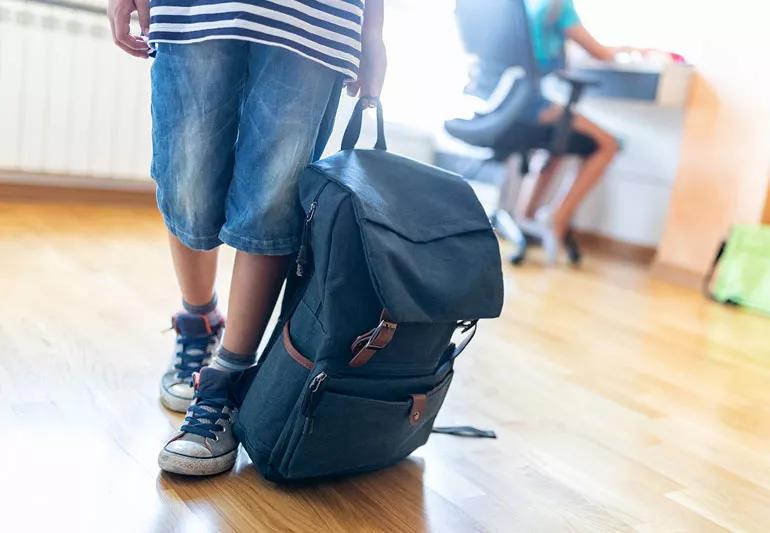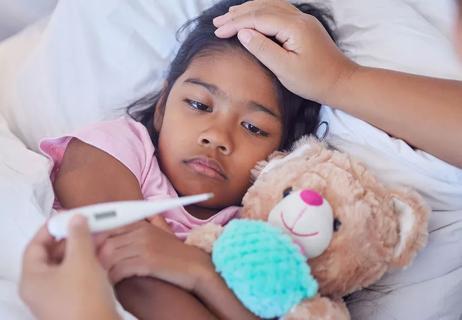For starters, pick the right size backpack for your child, with wide, padded straps

Back-to-school clothes? Check. Gym uniform? Check. Lunch bag, school supplies, backpack? Check, check, check! If you’re like most parents, you’ve got about a million items to check off your list when it comes to prepping for a new school year.
Advertisement
Cleveland Clinic is a non-profit academic medical center. Advertising on our site helps support our mission. We do not endorse non-Cleveland Clinic products or services. Policy
But some items on that list require more than just a check mark — and that includes your kid’s school bag. Because how much your child’s backpack is stuffed with is just as important as making sure they get the right spiral notebook. If the contents of your kid’s bag could fill a small European car, it’s time to think about lightening the load.
And there are good reasons why.
Backpacks that are too heavy for a child not only cause discomfort, but they can also result in a variety of health problems down the road — especially if that weight is carried unchecked over the course of several years.
Pediatrician Ellen Rome, MD, MPH, and sports medicine specialist Michael Dakkak, DO, explain how much your child should be carrying, as well as share tips for making their school days a little lighter.
The American Academy of Pediatrics recommends a backpack should weigh no more than 15% of your child’s weight.
Dr. Rome echoes this, and recommends children carry no more than 10% to 15% of their body weight in their backpacks. For instance, 11 pounds is about the limit for an average third grader who weighs in at 75 pounds. But the best way is to weigh your child and compare it to the weight of their backpack.
Advertisement
To minimize what your kid is lugging around every day, start with your bathroom scale.
“You can physically put the backpack on the scale and figure out if it’s more than 10% to 15% of your kid’s body weight,” Dr. Rome says.
Here’s a formula to use to find out how close to 10% of your child’s weight their backpack is:
A heavy backpack can do more than cause temporary discomfort on a walk to school. In fact, there’s a reason it’s important to stick with the recommended weight because it can lead to long-term issues.
“A lot of times, we’ll see the weight take over the child and either the child will lean too far forward or too far backward,” explains Dr. Dakkak.
Exceeding the recommended weight can cause kids to develop back problems and strain around their neck and shoulders. Over time your child’s posture can also be affected if they lean either too far forward or backward to compensate for the pack’s heaviness, or as a reaction to an unequal distribution of weight in the backpack.
“Carrying heavy backpacks can also result in apophysitis, which is an inflammation of growth cartilage that can occasionally impact the shoulder,” adds Dr. Rome.
Aside from making sure your child is carrying the appropriate weight every day to school, there are other ways to make sure you’re minimizing any harm a heavy pack could be causing.
First, it’s important to have a backpack that’s the appropriate size for your child. Make sure you’re getting a backpack for a child and not an adult, as that could affect the overall weight they’re carrying. For reference, the pack should sit 2 inches above their hips.
Using the formula above, figure out the maximum your child should be carrying (remember that 15% of their body weight is really the most they should walk around with; 10% is ideal). If the backpack is at this weight or higher, you’ll need to take steps to reduce what they pack.
And while some kids may be dying to wear a crossbody or purse to school, unfortunately that’s another recipe for back pain and discomfort. “I think the biggest piece of advice is to remember that function is much more important than fashion,” points out Dr. Dakkak.
Another surefire way to lighten the weight your child is carrying is to simply figure out which books they really need at school that day. Chances are, your child won’t need every single textbook and notebook every school day.
Advertisement
“If you’re able to, at least once a week or every other week, clean out unnecessary items that are not being utilized in school to make sure that your child isn’t carrying redundant things,” recommends Dr. Dakkak.
Similarly, it’s also a good idea for your child to utilize their locker to give them a place to dump any supplies they won’t need during certain parts of the day.
Make sure your child’s backpack has a good support system.
Backpacks with tight, narrow straps that dig into shoulders can interfere with nerves and circulation, which can lead to tingling, numbness and weakness in arms and hands. Go for backpacks with broad base straps that are well-padded.
“Other backpacks may also include a strap that goes along the chest, and then also a strap around the waist to help give the child more support while carrying the heavy load,” notes Dr. Dakkak.
Also, remember that two straps are always better than one. “For the most part, we generally refrain from recommending the single strap or crossbody bags just because it does not distribute the load evenly,” he adds.
You can also balance out the weight they’re carrying by moving around the contents of the backpack. Put larger, heavier textbooks nearer your child’s body so when they’re running and swinging around, the centrifugal force of the backpack doesn’t cause loss of balance and a fall.
Advertisement
“It’s good to have a backpack that has multiple compartments because then you’re better able to distribute the weight along the backpack evenly,” states Dr. Dakkak. “This way, it’s not lopsided in terms of the amount of weight that the child is carrying side to side.”
While function should always trump fashion when it comes to carrying heavy books, Dr. Rome points out that there are still ways to make backpacks fun but also expressive for kids.
“Another creative solution is to get a rolling backpack,” she says. “Make it a style statement. Let them put as many stickers or whatever else on to make them feel special carrying it.”
Make sure your kids let you know if they’re experiencing back pain, tingling or numbness. Explain that it’s important for their health to not carry a backpack that’s too heavy.
“If a child is complaining of neck or back pain, that’s something that should not be taken lightly,” stresses Dr. Dakkak. “It certainly can be a sign that the load is too heavy and you should never be afraid to seek medical attention.”
There’s better news lately about the weight your child carries. Many kids these days aren’t required to carry multiple heavy textbooks the way kids in previous generations did. That big stack of extra-large textbooks is often now replaced with a small tablet or laptop computer.
Advertisement
The average weight of newer 2023 tablets generally weigh only about a half pound to 1 pound, and a computer might weigh about as much as one heavy textbook.
“These advances in tech are going a long way in helping kids keep their packs much more carryable,” Dr. Rome says.
But she recognizes that technology may not replace every book your child may have to carry. “Parents should still do a check-in into their child’s bag every so often,” she says.
Dr. Rome advises that if you see your child showing discomfort putting on or taking off a backpack, don’t ignore it — it’s another sign that it’s too heavy or the weight is unevenly distributed.
“Correcting these problems early on will go a long way to prevent problems in their future,” she encourages.
Learn more about our editorial process.
Advertisement

Preschool age is typically between 3 and 5 — but readiness may matter more

Asking questions, creating routines and setting schedules can help get students back on track

All states require DTaP, MMR, polio and chickenpox vaccines — healthcare providers recommend others, too

School can be stressful, even anxiety-provoking — get to the root of the concern and enlist help when needed

A well-balanced lunch should include a protein, whole grain, fruit and vegetables, and a healthy snack

‘Active shooter’ exercises may raise both awareness and anxiety

Focus on a positive mindset, strong study habits and healthy living

Vomiting and fevers are a hard no — other symptoms are a judgment call

Start having sex about 72 hours before ovulation, then at least every other day during your fertile window

Attachment theory suggests that your earliest relationships shape connections throughout your life

It isn’t a recognized mental health disorder, but research shows that problematic social media use can negatively affect your mental health, self-esteem and sleep